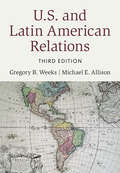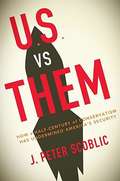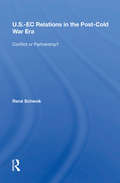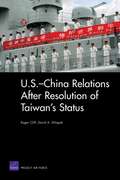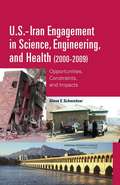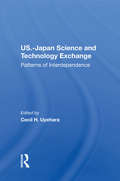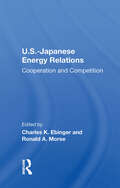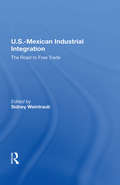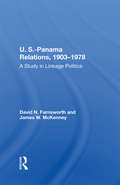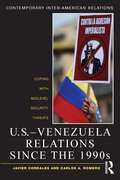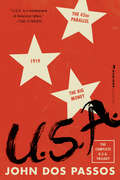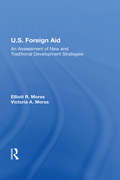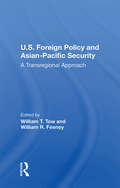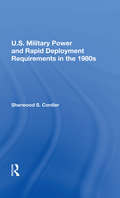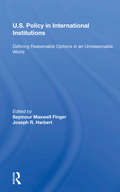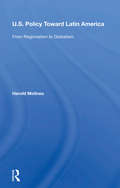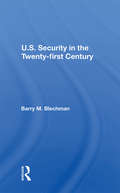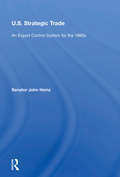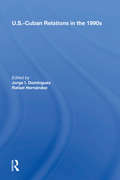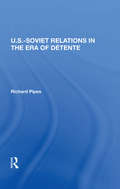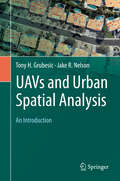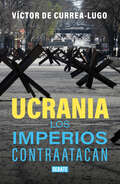- Table View
- List View
U.S. and Latin American Relations
by Gregory B. Weeks Michael E. AllisonThe third edition of U.S. and Latin American Relations offers detailed theoretical and historical analyses essential for understanding contemporary US-Latin American relations. Utilizing four different theories (realism, liberal institutionalism, dependency, and autonomy) as a framework, the text provides a succinct history of relations from Latin American independence through the Covid-19 era before then examining critical contemporary issues such as immigration, human rights, and challenges to US hegemony. Engaging pedagogical features such as timelines, research questions, and annotated resources appear throughout the text, along with relevant excerpts from primary source documents. The third edition features a new chapter on the role of extrahemispheric actors such as China and Russia, as well as a significantly revised chapter on citizen insecurity that examines crime, drug trafficking, and climate change. Instructor resources include a test bank, lecture slides, and discussion questions.
U.S. vs. Them
by J. Peter ScoblicA challenging, clear-eyed, and authoritative history of American conservatism and its grave effect on our country's foreign policy In this compelling and sometimes alarming analysis, J. Peter Scoblic, executive editor of The New Republic, traces the history of American foreign policy and how it has evolved from the Cold War conservatism of the 1950s to today. The belligerence, intransigence, and disinclination for diplomacy that mars the right wing once brought us to the brink of nuclear war with the Soviet Union. More recently it has failed to meet the post-9/11 challenges posed by Iraq, Iran, and North Korea. Scoblic argues forcefully that the only way to face these new threats practically and seriously is by adopting an approach exactly opposite to that suggested by conservatism. By diagnosing the origins of Bush's foreign policy, U.S. vs. Them illuminates the path to renewed American leadership in the twenty-first century as the most serious danger ever faced looms before us: nuclear terrorism.
U.S.- EC Relations In The Post-cold War Era: Conflict Or Partnership?
by Rene SchwokRelations between the European Community and the United States are taking on a new momentum. Are we heading towards a period of greater US-EC co-operation, or will the rapidly changing economic structure in Europe lead to possible conflicts across the Atlantic? This book offers an analysis of the economic implications of the current European Commu
U.S.-China Relations After Resolution of Taiwan's Status
by Roger Cliff David A. ShlapakAlthough the question of Taiwan's status may not be resolved soon, considering various outcomes and their possible effects on U.S.-China relations is useful. Ten trajectories for the resolution of Taiwan's status are given, with effects on U.S.-China relations ranging from close cooperation to cold war. As China's military capabilities grow, it will become more difficult but more important to prevent Beijing from trying to use force against Taiwan.
U.S.-China Strategic Relations and Competitive Sports: Playing for Keeps
by David LaiThis book investigates cultural influences of competitive sports on U.S. and Chinese strategic thinking and tactical behavior. Most competitive sports owe their origins to human fighting. Although they are “ritualized contests,” competitive sports have retained many aspects of human warfare, especially the use of strategy and tactics that moves human contest beyond military clashes to the subjugation of opponents without bloodshed. Cultural influences usually go unnoticed. Indeed, Washington often conducts foreign affairs like football games without knowing that is the case. Likewise, Beijing moves in Weiqi style subconsciously. This book uncovers these influences.
U.S.-Habsburg Relations from 1815 to the Paris Peace Conference
by Nicole M. PhelpsThis study provides the first book-length account of U. S. -Habsburg relations from their origins in the early nineteenth century through the aftermath of World War I and the Paris Peace Conference. By including not only high-level diplomacy but also an analysis of diplomats' ceremonial and social activities, as well as an exploration of consular efforts to determine the citizenship status of thousands of individuals who migrated between the two countries, Nicole M. Phelps demonstrates the influence of the Habsburg government on the integration of the United States into the nineteenth-century Great Power System and the influence of American racial politics on the Habsburg Empire's conceptions of nationalism and democracy. In the crisis of World War I, the U. S. -Habsburg relationship transformed international politics from a system in which territorial sovereignty protected diversity to one in which nation-states based on racial categories were considered ideal.
U.S.-Iran Engagement in Science, Engineering, and Health (2000-2009): Opportunities, Constraints, and Impacts
by National Research Council of the National AcademiesDuring the first decade of the 21st century, the National Academies, working with a number of partner organizations in Iran, carried out a program of U.S.-Iran engagement in science, engineering, and health (herein referred to as science engagement). This book reviews important aspects of the science engagement program, including: (a) objectives of the program, (b) opportunities and constraints in developing the program, and (c) scientific and political impacts of the activities. Suggestions for future activities that draw on the conclusions and recommendations that have emerged from workshops and other types of interactions are set forth. Of course, the political turmoil within Iran and uncertainties as to the direction of U.S.-Iran government-to-government relations will undoubtedly complicate initiation and implementation of new science engagement activities in the near term. At the same time, many American and Iranian participants and important government officials in the United States and Iran have believed that science engagement can contribute to the evolution of an improved political environment for development of less adversarial relations between the two governments.
U.S.-Japan Science And Technology Exchange: Patterns Of Interdependence
by Cecil H UyeharaAn account of the 1988 US-Japan Science and Technology Agreement (88STA). The research methodology of the study is based on interviews and analysis of the relevant documents and articles augmented by an analysis of selected studies on US-Japan and science and technology relations. The author hopes to: increase the reader's understanding of the bureaucratic process and negotiations within the US and Japanese government in drafting an agreement and the interaction of the negotiators in the outcome; increase our knowledge about how the US-Japanese relationship in science and technology in the public sector is managed; throw some light on how domestic factors impact on preparing for a negotiating a new agreement between the US and Japan on science and technology; develop insights into the negotiating styles of each country; assess its role as a model agreement for negotiating similar agreements with other countries; learn some lessons for future negotiations with Japan in the science and technology area and with other countries if this Agreement is to be used as a model
U.S.-Japanese Energy Relations: Cooperation And Competition
by Charles EbingerOriginally published in 1984, this collection of original papers highlights the major problems and challenges that lie ahead in U.S.-Japanese energy relations. Energy cooperation, both through joint projects and bilateral planning, has become an important barometer of the U.S. diplomatic relationship with Japan, as evidenced by the high-level U.S.-Japan Energy Working Group set up in January 1984 following Prime Minister Nakasone's visit to Washington. Contributions to this book detail the problems posed by energy security differences and uncertain oil markets; U.S. crude oil exports to Japan; and nuclear, coal solar-energy; and they consider the prospects for conflict over investment in Siberia and Asia
U.S.-Mexican Industrial Integration: The Road To Free Trade
by Sidney WeintraubThis book assesses economic cooperation and industrial integration between the United States and Mexico from the perspective of six specific industries—automobiles, computers, food processing, petrochemicals, pharmaceuticals, and textiles and apparel.
U.S.-Panama Relations, 1903-1978: A Study In Linkage Politics
by David N FarnsworthThis book traces relations between the United States and Panama from 1903 to 1978, focusing especially on the Panama Canal dispute. It emphasizes the extent to which the domestic politics of each country influence decisions about foreign policy and about the canal treaty negotiations.
U.S.-Venezuela Relations since the 1990s: Coping with Midlevel Security Threats
by Javier Corrales Carlos A. RomeroOil makes up one-third of Venezuela's entire GDP, and the United States is far and away Venezuela's largest trading partner. Relations between Venezuela and the United States, traditionally close for most of the last two centuries, began to fray as the end of the Cold War altered the international environment. U.S.-Venezuela Relations since the 1990s explores relations between these two countries since 1999, when Hugo Chavez came to office and proceeded to change Venezuela's historical relation with the United States and other democracies. The authors analyze the reasons for rising bilateral conflict, the decision-making process in Venezuela, the role played by public and private actors in shaping foreign policy, the role of other powers such as China, Russia, Iran, and Saudi Arabia in shaping U.S.-Venezuelan relations, the role of Venezuela in Cuba and Colombia, and the impact of broader international dynamics in the bi-lateral relations.
U.S.A.: The Complete Trilogy [The 42nd Parallel, 1919, and The Big Money] (U.S.A. Trilogy #3)
by John Dos PassosU.S.A. has descriptive copy which is not yet available from the Publisher.
U.s. Foreign Policy And Asian-pacific Security: A Transregional Approach
by William T TowThe Reagan administration has indicated clearly that the United States will reassert its strategic presence in Asia and the Pacific at levels not equalled since the close of the Vietnam conflict. The implications of this policy bear careful examination in light of the growing divergence between U.S. security perceptions and those of our European an
U.s. Leadership in Wartime: Volume 2
by Spencer TuckerPresident Harry S. Truman's 1951 firing of Douglas MacArthur ended the nation's most famous showdown between a commander in chief and a high-profile officer--but it was far from the only time a chief executive and a general clashed.
U.s. Military Power And Rapid Deployment Requirements In The 1980s
by Sherwood S CordierThis book assesses U.S. military needs in the coming decade, focusing on the role of rapid deployment forces in protecting U.S. interests abroad. Dr. Cordier begins by discussing two general developments crucial to future military requirements: first, increasing U.S. dependence on the global sea-lanes as links to key markets; and second, improved S
U.s. Policy In International Institutions: Defining Reasonable Options In An Unreasonable World--special Student Edition, Updated And Revised
by Seymour Maxwell FingerIn the immediate post-war period the United States was predominant economically and could command a majority in the U.N. General Assembly; it now faces an increasingly interdependent world economy and an assembly dominated by the Third World. The essays in this book analyze the U.N. system as it functions today. Contributors stress the economic iss
U.s. Policy Toward Latin America: From Regionalism To Globalism
by Harold MolineuRecent U.S. military involvement in Central America has sparked heated debate over U.S. policy in the region. To informed observers of U.S.-Latin American relations, however, Washington's actions reflect U.S. regional and global objectives that have evolved in the course of 150 years of U.S. involvement in Latin America. This text provides students
U.s. Security In The Twenty-first Century
by Barry M BlechmanHow will the international environment change, and what will be the shape of U.S. security policies twenty years from today? Barry Blechman answers these questions by analyzing the many variables that will influence the international arena. Some factors—such as demographic trends--change slowly and can be forecast with confidence. Others depend mor
U.s. Strategic Trade: An Export Control System For The 1990s
by John HeinzThis book presents a thorough review of U.S. and allied export control policies since World War Il. It presents a historical perspective of how U.S. got into the bureaucratic logjam. The book provides practical and understandable blueprint for the reorganization of the export control function.
U.s.-cuban Relations In The 1990s
by Jorge I DominguezThe contributors and editors purpose in this book is to sketch where and why the United States and Cuba differ; to identify the issues where differences are likely to endure because they stem from the central values and interests of such different political and economic regimes; and to point to those other issues where skillful diplomacy might fin
U.s.-soviet Relations In The Era Of Detente
by Richard E PipesThis book contains the papers on Soviet foreign policy, concentrating on the constants that form the bedrock of Soviet policy and the Soviet variant of a policy of detente. It deals with the cultural-historical background that lies behind the political outlooks of the United States and Russia.
UAVs and Urban Spatial Analysis: An Introduction
by Tony H. Grubesic Jake R. NelsonThis book provides an introduction to the use of unmanned aerial vehicles (UAVs) for the geographic observation and spatial analysis of urban areas. The velocity of urban change necessitates observation platforms that not only enhance situational awareness for planning and allied analytical efforts, but also provide the ability to rapidly and inexpensively collect data and monitor change. UAVs can accomplish both of these tasks, but their use in urban environments is loaded with social, operational, regulatory and technical challenges that must be addressed for successful deployments. The book provides a resource for educators and students who work with geographic information and are seeking to enhance these data with the use of unmanned aerial vehicles. Topics covered include, 1) a primer on UAVs and the many different ways they can be used for geographic observation, 2) a detailed overview on the use of aviation maps and charts for operating UAVs in complex urban airspace, 3) techniques for integrating UAV-derived data with more traditional geographic information, 4) application of spatial analytical tools for urban and environmental planning, and 5) an exploration of privacy and public safety issues associated with UAV operation.
UCRANIA. LOS IMPERIOS CONTRAATACAN
by Víctor De Currea-LugoUn acercamiento a la guerra actual entre Ucrania y Rusia desde el periodismo. En un mundo polarizado y, vale decirlo, poco informado, hay una tendencia a explicar los conflictos armados a través de una única causa o negando sus aristas y matices. Este trabajo invita a la mirada compleja de una guerra con implicaciones globales de orden social, económico y político. Las diferentes piezas del rompecabezas ucraniano incluyen: la ocupación rusa, la guerra de Donbás, el persistente pensamiento imperial, las formaciones neonazis, el derecho internacional fallido, la expansión de la OTAN y la crisis humanitaria más grande de Europa en décadas. En este libro los lectores encontrarán información que el autor recogió de primera mano durante abril de 2022, a pocos meses de haberse iniciado la invasión, en un intento de entender la guerra entre Ucrania y Rusia al verla personalmente, al igual que lo ha hecho con otros conflictos
